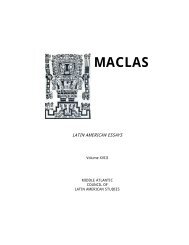latin american essays maclas
latin american essays maclas
latin american essays maclas
Create successful ePaper yourself
Turn your PDF publications into a flip-book with our unique Google optimized e-Paper software.
THE LATIN AMERICAN FASHION READER, Regina A. Root,<br />
ed.,<br />
New York: Berg Publishers, 2005.<br />
Brian Turner<br />
Randolph-Macon College<br />
The Latin American Fashion Reader, edited by Regina A. Root, Associate<br />
Professor of Hispanic Studies at The College of William and Mary, received the<br />
Arthur P. Whitaker Prize at the MACLAS XXVII in Ponce, Puerto Rico, for the best<br />
book published by a MACLAS member in 2004-2005. The volume is the first to<br />
focus on Latin America in the Berg series “Dress, Body, Culture.” It includes<br />
seventeen <strong>essays</strong> by specialists in history, anthropology, literature, women’s<br />
studies, textiles and clothing, design and merchandising, and Latin American<br />
studies and civilization. The <strong>essays</strong> range cross-temporally from the colonial<br />
period to the contemporary fashion industry. While covering an extraordinary<br />
range of topics and cultural forms, the volume successfully weaves together the<br />
authors’ sophisticated theoretical and interdisciplinary approaches.<br />
The book is organized into four multi-essay parts. Part one focuses on the<br />
use of dress in colonial and early republican societies to mark ethnic, national,<br />
and gender identities. Root’s essay, “Fashioning Independence: Gender, Dress<br />
and Social Space in Postcolonial Argentina,” identifies women’s use, and<br />
according to some observers abuse, of the giant peinetón, or comb, as an<br />
adornment. With the peinetón, Root argues, women asserted their place in the<br />
republican social order. That politicized assertion provoked its backlash, and by<br />
the 1830s its use was interpreted by critics as immoral and anti-government.<br />
Araceli Tinajero’s “Far Eastern Influences in Latin American Fashions” covers<br />
much more historical time, reminding us that what we now call ‘globalization’<br />
began at least as early as the establishment of the Manila-Acapulco trade in the<br />
sixteenth century, and its cultural forms have influenced Latin American fashion<br />
in a wide variety of ways.<br />
The <strong>essays</strong> in part two provide nuanced explorations of “altered traditions”<br />
of indigenous textile production, demonstrating that indigenous people have<br />
agency in their interactions with the global tourist trade. Far from mourning the<br />
loss of meaningful traditions, <strong>essays</strong> such as Blenda Femenías’ “‘Why do Gringos<br />
Like Black’ Mourning Tourism, and Changing Fashions in Peru,” and Elyse<br />
Demaray, Melody Keim-Shenk, and Mary A. Littrell’s “Representations of<br />
Tradition in Latin American Boundary Textile Art,” show how highland weavers<br />
are capable of promoting ethnic identity as well as commercializing their<br />
production, although with a dynamic interplay that does indeed alter the<br />
presentation and meaning of identity.<br />
Part three, “Fashion and the Cultural Imaginary,” discusses the<br />
intersection of fashion and national identity. Ruth Corcuera’s “Ponchos of the<br />
138




